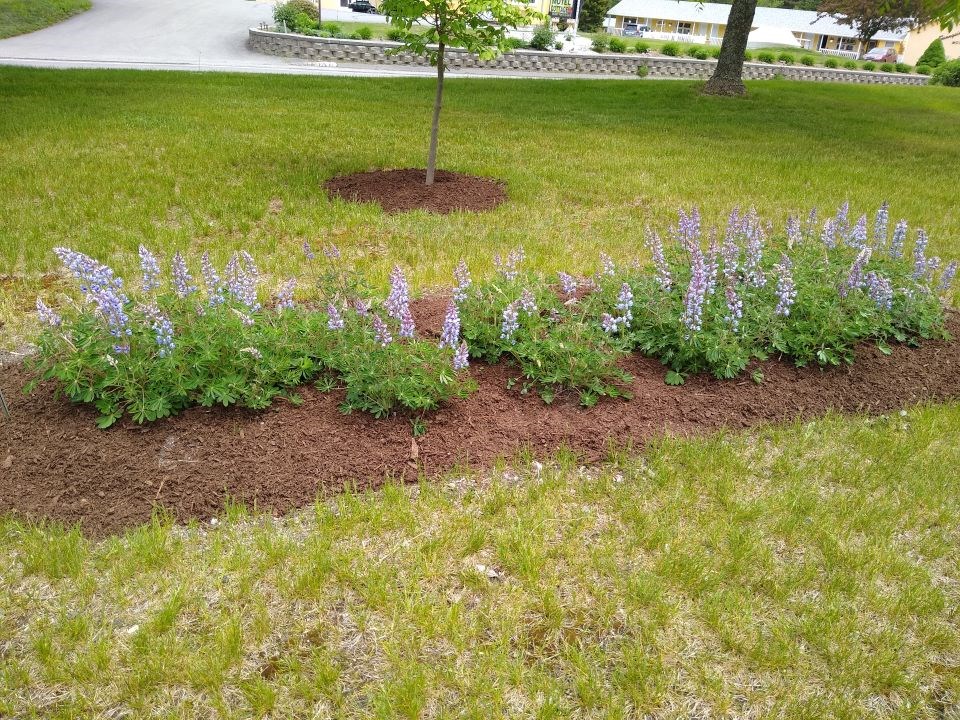Last updated: February 2, 2023
Article
A Tale of Two Lupines

Bar Harbor Garden Club
Less than a century ago, visitors wouldn’t have seen fields awash with purple flowers on a summer drive to Acadia National Park. In fact, while there are hundreds of lupine species worldwide, only one has historically been found growing wild in Maine: the sundial lupine, Lupinus perennis. The sundial lupines planted at the Hulls Cove Visitor Center by the Bar Harbor Harden Club closely resemble today’s roadside flowers, yet Maine’s native lupine species is now considered extirpated, or locally extinct. The western lupine, Lupinus polyphyllus, has taken its place. These two species may look alike but have very different stories to tell.


Left image
L. perennis, Maine's native lupine
Credit: Bruce Patterson. Used with permission.
Right image
L. polyphyllus, non-native to Maine
Credit: Marilee Lovit. Used with permission.

Most lupines are perennial plants with tall spikes made up of many flowers. Their whorled, palmately compound leaves are distinctive--you might say the leaf looks like a sundial, with leaflets pointing out from the center like the hands of a clock. Lupines and other plants of the legume family (Fabaceae) produce seed pods but quickly spread via root shoots as well. This family also shares a symbiotic relationship with bacteria that convert nitrogen in the air to a form that plants can absorb from the soil. Nitrogen fixation is the reason behind planting beans as a garden companion (or introducing the notorious invasive plant kudzu to prevent erosion). Lupines grow well in nutrient poor gravelly soil of fields, meadows, roadsides, and cleared rights-of-way.

NPS Photo/Jim Kaftan, NPS Photo, NPS Photo/Brendan Morgan, USFWS/Katie Goodwin

“The Island flora contains only eighteen species [in the Fabaceae family]…obviously a very insufficient representation when we consider that shown by many points further north with otherwise much the same flora. Of these species, ten are naturalized on this continent from Europe; two are introduced from other parts of North America; two more may also have been so introduced; leaving only four species that are indigenous…When northern species of this family are introduced on the Island they flourish as well there as elsewhere.”
It is estimated that western lupine was introduced to the northeast by the 1950s, and it certainly flourishes on the island today. Colorful hybrids and cultivars of lupines thrived on the island. Western lupine’s attractive flowers and prolific growth soon carried it beyond the garden walls, along with other species that are managed by Acadia’s Invasive Plant Management Team (IPMT) today. Intentionally planted along roadsides and quick to spread on its own, western lupine eventually displaced the sundials throughout the northeast.
When L. polyphyllus first came to Mount Desert Island is not known exactly, but it spread during a period of rapid development, road construction, increased visitation, and other environmental disturbances such as the Fire of 1947. The added stressors of soil compaction and degradation on native vegetation, coupled with the western lupine’s larger size and higher tolerance for these conditions, allowed it to outcompete and crowd out other plants. This origin story is common among many invasive plant species. In parts of the Midwest and Northeast, western lupine is considered an invasive species, meaning its introduction has caused economic or environmental harm or harm to human health. In some areas, the lupine’s abundance and ability to add nutrients to the soil can significantly increase nitrogen levels beyond what native species can tolerate. Though its sale is not restricted in the state, it is included on the Maine DACF Advisory List for its invasive potential.

Bar Harbor Garden Club
On Mount Desert Island, documenting the presence of sundial lupine and its rare pollinators remains a natural history mystery. In planting sundial lupines within an approximate historical range, the BHGC hopes to share appreciation for this iconic flower, encourage the use of native plants in home gardens, and provide the far-reaching benefits of restoring native plants to Maine’s landscapes.
